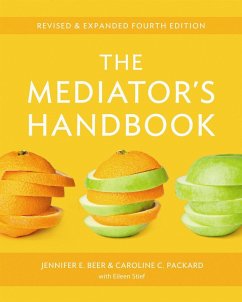Jennifer E. Beer, Caroline C. Packard
The Mediator's Handbook (eBook, ePUB)
Revised & Expanded fourth edition
17,95 €
17,95 €
inkl. MwSt.
Sofort per Download lieferbar

9 °P sammeln
17,95 €
Als Download kaufen

17,95 €
inkl. MwSt.
Sofort per Download lieferbar

9 °P sammeln
Jetzt verschenken
Alle Infos zum eBook verschenken
17,95 €
inkl. MwSt.
Sofort per Download lieferbar
Alle Infos zum eBook verschenken

9 °P sammeln
Jennifer E. Beer, Caroline C. Packard
The Mediator's Handbook (eBook, ePUB)
Revised & Expanded fourth edition
- Format: ePub
- Merkliste
- Auf die Merkliste
- Bewerten Bewerten
- Teilen
- Produkt teilen
- Produkterinnerung
- Produkterinnerung

Bitte loggen Sie sich zunächst in Ihr Kundenkonto ein oder registrieren Sie sich bei
bücher.de, um das eBook-Abo tolino select nutzen zu können.
Hier können Sie sich einloggen
Hier können Sie sich einloggen
Sie sind bereits eingeloggt. Klicken Sie auf 2. tolino select Abo, um fortzufahren.

Bitte loggen Sie sich zunächst in Ihr Kundenkonto ein oder registrieren Sie sich bei bücher.de, um das eBook-Abo tolino select nutzen zu können.
The classic resource for effective mediation - now fully updated and expanded
- Geräte: eReader
- mit Kopierschutz
- eBook Hilfe
- Größe: 4.05MB
Andere Kunden interessierten sich auch für
![The Mediator's Toolkit, Second Edition (eBook, ePUB) The Mediator's Toolkit, Second Edition (eBook, ePUB)]() Gerry O'SullivanThe Mediator's Toolkit, Second Edition (eBook, ePUB)26,95 €
Gerry O'SullivanThe Mediator's Toolkit, Second Edition (eBook, ePUB)26,95 €![The Art of Focused Conversation, Second Edition (eBook, ePUB) The Art of Focused Conversation, Second Edition (eBook, ePUB)]() The Art of Focused Conversation, Second Edition (eBook, ePUB)20,95 €
The Art of Focused Conversation, Second Edition (eBook, ePUB)20,95 €![Mediation and Dispute Resolution (eBook, ePUB) Mediation and Dispute Resolution (eBook, ePUB)]() Tony WhatlingMediation and Dispute Resolution (eBook, ePUB)24,95 €
Tony WhatlingMediation and Dispute Resolution (eBook, ePUB)24,95 €![The Psychology of Conflict (eBook, ePUB) The Psychology of Conflict (eBook, ePUB)]() Paul RandolphThe Psychology of Conflict (eBook, ePUB)26,95 €
Paul RandolphThe Psychology of Conflict (eBook, ePUB)26,95 €![The Structure of Investment Arbitration (eBook, ePUB) The Structure of Investment Arbitration (eBook, ePUB)]() Tony ColeThe Structure of Investment Arbitration (eBook, ePUB)47,95 €
Tony ColeThe Structure of Investment Arbitration (eBook, ePUB)47,95 €![Arbitration Clauses and Third Parties (eBook, ePUB) Arbitration Clauses and Third Parties (eBook, ePUB)]() Asli ArdaArbitration Clauses and Third Parties (eBook, ePUB)142,95 €
Asli ArdaArbitration Clauses and Third Parties (eBook, ePUB)142,95 €![The Joy of Conflict Resolution (eBook, ePUB) The Joy of Conflict Resolution (eBook, ePUB)]() Gary HarperThe Joy of Conflict Resolution (eBook, ePUB)15,95 €
Gary HarperThe Joy of Conflict Resolution (eBook, ePUB)15,95 €-
-
-
The classic resource for effective mediation - now fully updated and expanded
Dieser Download kann aus rechtlichen Gründen nur mit Rechnungsadresse in A, D ausgeliefert werden.
Produktdetails
- Produktdetails
- Verlag: New Society Publishers
- Seitenzahl: 208
- Erscheinungstermin: 13. November 2012
- Englisch
- ISBN-13: 9781550925166
- Artikelnr.: 38324342
- Verlag: New Society Publishers
- Seitenzahl: 208
- Erscheinungstermin: 13. November 2012
- Englisch
- ISBN-13: 9781550925166
- Artikelnr.: 38324342
- Herstellerkennzeichnung Die Herstellerinformationen sind derzeit nicht verfügbar.
Dr. Jennifer E. Beer, PhD, combines mediation experience with her cultural anthropology background to lead courses and workshops in mediation, conflict resolution, and cross-cultural communication. She regularly teaches a negotiation course at Wharton (University of Pennsylvania). Author of The Mediator's Handbook and of Peacemaking in Your Neighborhood, she has mediated conflicts and facilitated meetings for communities and organizations for 30 years.
Caroline C Packard, JD, is an organizational change and conflict response specialist and mediator with 30 years' experience in the field. She led Friends Conflict Resolution Programs for 15 years, and has trained hundreds of mediators. A cum laude graduate of Yale College and NYU School of Law, and a former corporate litigator with extensive formal training in individual and group psychology, Caroline has a special interest in the evolutionary psychology of group conflict and cooperation. She provides mediation and conflict-resolution services and training to organizations, families, and family businesses.
Eileen Stief developed the mediation process and principles documented in The Mediator's Handbook, and trained a generation of mediators to work with community, multi-party, and environmental disputes. Now retired, she led the Friends Conflict Resolution Program's experiment in community dispute settlement and later specialized in environmental mediation.
Elizabeth Elwood Gates provided the delightful cartoon illustrations in honor of her aunt, Ann Richan, who was a passionate champion of community mediation.
Caroline C Packard, JD, is an organizational change and conflict response specialist and mediator with 30 years' experience in the field. She led Friends Conflict Resolution Programs for 15 years, and has trained hundreds of mediators. A cum laude graduate of Yale College and NYU School of Law, and a former corporate litigator with extensive formal training in individual and group psychology, Caroline has a special interest in the evolutionary psychology of group conflict and cooperation. She provides mediation and conflict-resolution services and training to organizations, families, and family businesses.
Eileen Stief developed the mediation process and principles documented in The Mediator's Handbook, and trained a generation of mediators to work with community, multi-party, and environmental disputes. Now retired, she led the Friends Conflict Resolution Program's experiment in community dispute settlement and later specialized in environmental mediation.
Elizabeth Elwood Gates provided the delightful cartoon illustrations in honor of her aunt, Ann Richan, who was a passionate champion of community mediation.
Preface
Overview
What is mediation?
A useful tool
What makes mediation work?
The mediator's role
The anatomy of the mediation process
The anatomy of a session
Process-centered mediation
Guiding principles
Mediation terms
THE PROCESS
Getting to the Table
Can mediation help this situation?
How people find a mediator
Voluntary or mandatory?
Initial conversations
Do they want to participate?
Defining the scope
Approaching the other parties
Should I be the mediator?
Pre-mediation agreements and review
Choosing a location
The Mediation Session Part I: Exploring the Situation
Preparing yourself, co-mediators
Setting up
Opening
Opening: Welcome & warm-up
Opening: Logistics
Opening: Orientation
Opening: Participants' role, willingness
Listening to Each Perspective
The Exchange
The Exchange: Facilitating
The Exchange: Tasks & flow
Clarify information
Check out interpretations
Listen for their concerns
Example + impact
Restate their interests
Note other relevant interests
Encourage empathy and reconciliation
Transition to Reaching Resolution
Separate Conversations
Uses for Separate Conversations
Breaking for Separate Conversations
Separate Conversations: Template
The Mediation Session Part II: Reaching Resolution
Reaching Resolution
Reaching Resolution: Sequence
Topic List
Topic List: Why it is crucial
Topic List: Drafting
Topic List: Wording
Midpoint check-in
Options
Options: Together come up with ideas
Options: Gut, interests, workability
Options: Reality testing
Decisions
Decisions: Gut, interests, workability
Decisions: Emotions, hesitations
Writing the Agreement
Writing the Agreement: Specifics
Writing the Agreement: Positive framing
Closing
Afterwards: Wrapping up
Multiple sessions
THE TOOLBOX
Understanding Conflict
Disputes & conflicts
Metaphors for understanding conflict
The conflict core
Common effects of conflict
The pleasures of conflict
When things heat up
The way out is through
The Conflict Triangle
People, Process, Problem
Which mode are you in?
Supporting the People
Supporting the people: Main skills
Setting the tone
Level of formality, taking notes
Confidentiality in practice
Giving your full attention
Elements of full attention
Acknowledging
Handling judgmental remarks
Protecting
From adversarial mode to cooperative mode
Avoid this Kettle of Fish
Attending to comfort & accessibility
Language and hearing difficulties
Working with people in all their variety
Finding commonalities
Scenarios: Emotionally difficult situations 111
Facilitating the Process
Facilitating the process
Impartial facilitation
Structuring the session
Structuring the discussion
When you can be directive
When to consult
Keeping on track
Crafting questions
Crafting questions: Word with care
Crafting questions: Spin it positive
Crafting questions: Follow up for clarification
Kinds of rewording
Reflecting back
Summarizing
Summarizing: Its many uses
Working visually
When to intervene
When to intervene: Stopping the momentum
When to intervene: Slowing the process down
Is it time to quit?
Ending a mediation
Scenarios: Facilitation challenges
Solving the Problem
Participants' starting point: Power & rights
Changing the "positions" mindset
Interests
Layers of interests
Why interests matter
Finding space for solutions
Reframing
Checking out (mis)interpretations
Lies, perceptions, deceptions
Plain description of facts and needs
Flip it! ? Outcome-focused interests
Tactful wording of interests and topics
Summary of interests
Topic List examples
Eliciting ideas: Brainstorming
Eliciting ideas: Opening up possibilities
Can mediators suggest options?
Visual aids for making decisions
Types of resolution
"Typical" or "good enough" resolutions
What-ifs
Fallbacks: Contingencies, uncertainties
Step-down agreements: Smaller scope
When there's no agreement
Final review: Workability
Final review: Future
Sample agreements
Scenarios: problem-solving challenges 173
Going Further
Going further
Adapting the process
Mediating with children & teens
Mediating across generations
Mediating family conflicts
Mediating employee conflicts
Participant evaluation
Mediator evaluation of a mediation
Evaluating yourself
The Handbook "soup pot"
Authors & contributors
Organizational support
Index
Overview
What is mediation?
A useful tool
What makes mediation work?
The mediator's role
The anatomy of the mediation process
The anatomy of a session
Process-centered mediation
Guiding principles
Mediation terms
THE PROCESS
Getting to the Table
Can mediation help this situation?
How people find a mediator
Voluntary or mandatory?
Initial conversations
Do they want to participate?
Defining the scope
Approaching the other parties
Should I be the mediator?
Pre-mediation agreements and review
Choosing a location
The Mediation Session Part I: Exploring the Situation
Preparing yourself, co-mediators
Setting up
Opening
Opening: Welcome & warm-up
Opening: Logistics
Opening: Orientation
Opening: Participants' role, willingness
Listening to Each Perspective
The Exchange
The Exchange: Facilitating
The Exchange: Tasks & flow
Clarify information
Check out interpretations
Listen for their concerns
Example + impact
Restate their interests
Note other relevant interests
Encourage empathy and reconciliation
Transition to Reaching Resolution
Separate Conversations
Uses for Separate Conversations
Breaking for Separate Conversations
Separate Conversations: Template
The Mediation Session Part II: Reaching Resolution
Reaching Resolution
Reaching Resolution: Sequence
Topic List
Topic List: Why it is crucial
Topic List: Drafting
Topic List: Wording
Midpoint check-in
Options
Options: Together come up with ideas
Options: Gut, interests, workability
Options: Reality testing
Decisions
Decisions: Gut, interests, workability
Decisions: Emotions, hesitations
Writing the Agreement
Writing the Agreement: Specifics
Writing the Agreement: Positive framing
Closing
Afterwards: Wrapping up
Multiple sessions
THE TOOLBOX
Understanding Conflict
Disputes & conflicts
Metaphors for understanding conflict
The conflict core
Common effects of conflict
The pleasures of conflict
When things heat up
The way out is through
The Conflict Triangle
People, Process, Problem
Which mode are you in?
Supporting the People
Supporting the people: Main skills
Setting the tone
Level of formality, taking notes
Confidentiality in practice
Giving your full attention
Elements of full attention
Acknowledging
Handling judgmental remarks
Protecting
From adversarial mode to cooperative mode
Avoid this Kettle of Fish
Attending to comfort & accessibility
Language and hearing difficulties
Working with people in all their variety
Finding commonalities
Scenarios: Emotionally difficult situations 111
Facilitating the Process
Facilitating the process
Impartial facilitation
Structuring the session
Structuring the discussion
When you can be directive
When to consult
Keeping on track
Crafting questions
Crafting questions: Word with care
Crafting questions: Spin it positive
Crafting questions: Follow up for clarification
Kinds of rewording
Reflecting back
Summarizing
Summarizing: Its many uses
Working visually
When to intervene
When to intervene: Stopping the momentum
When to intervene: Slowing the process down
Is it time to quit?
Ending a mediation
Scenarios: Facilitation challenges
Solving the Problem
Participants' starting point: Power & rights
Changing the "positions" mindset
Interests
Layers of interests
Why interests matter
Finding space for solutions
Reframing
Checking out (mis)interpretations
Lies, perceptions, deceptions
Plain description of facts and needs
Flip it! ? Outcome-focused interests
Tactful wording of interests and topics
Summary of interests
Topic List examples
Eliciting ideas: Brainstorming
Eliciting ideas: Opening up possibilities
Can mediators suggest options?
Visual aids for making decisions
Types of resolution
"Typical" or "good enough" resolutions
What-ifs
Fallbacks: Contingencies, uncertainties
Step-down agreements: Smaller scope
When there's no agreement
Final review: Workability
Final review: Future
Sample agreements
Scenarios: problem-solving challenges 173
Going Further
Going further
Adapting the process
Mediating with children & teens
Mediating across generations
Mediating family conflicts
Mediating employee conflicts
Participant evaluation
Mediator evaluation of a mediation
Evaluating yourself
The Handbook "soup pot"
Authors & contributors
Organizational support
Index
Preface
Overview
What is mediation?
A useful tool
What makes mediation work?
The mediator's role
The anatomy of the mediation process
The anatomy of a session
Process-centered mediation
Guiding principles
Mediation terms
THE PROCESS
Getting to the Table
Can mediation help this situation?
How people find a mediator
Voluntary or mandatory?
Initial conversations
Do they want to participate?
Defining the scope
Approaching the other parties
Should I be the mediator?
Pre-mediation agreements and review
Choosing a location
The Mediation Session Part I: Exploring the Situation
Preparing yourself, co-mediators
Setting up
Opening
Opening: Welcome & warm-up
Opening: Logistics
Opening: Orientation
Opening: Participants' role, willingness
Listening to Each Perspective
The Exchange
The Exchange: Facilitating
The Exchange: Tasks & flow
Clarify information
Check out interpretations
Listen for their concerns
Example + impact
Restate their interests
Note other relevant interests
Encourage empathy and reconciliation
Transition to Reaching Resolution
Separate Conversations
Uses for Separate Conversations
Breaking for Separate Conversations
Separate Conversations: Template
The Mediation Session Part II: Reaching Resolution
Reaching Resolution
Reaching Resolution: Sequence
Topic List
Topic List: Why it is crucial
Topic List: Drafting
Topic List: Wording
Midpoint check-in
Options
Options: Together come up with ideas
Options: Gut, interests, workability
Options: Reality testing
Decisions
Decisions: Gut, interests, workability
Decisions: Emotions, hesitations
Writing the Agreement
Writing the Agreement: Specifics
Writing the Agreement: Positive framing
Closing
Afterwards: Wrapping up
Multiple sessions
THE TOOLBOX
Understanding Conflict
Disputes & conflicts
Metaphors for understanding conflict
The conflict core
Common effects of conflict
The pleasures of conflict
When things heat up
The way out is through
The Conflict Triangle
People, Process, Problem
Which mode are you in?
Supporting the People
Supporting the people: Main skills
Setting the tone
Level of formality, taking notes
Confidentiality in practice
Giving your full attention
Elements of full attention
Acknowledging
Handling judgmental remarks
Protecting
From adversarial mode to cooperative mode
Avoid this Kettle of Fish
Attending to comfort & accessibility
Language and hearing difficulties
Working with people in all their variety
Finding commonalities
Scenarios: Emotionally difficult situations 111
Facilitating the Process
Facilitating the process
Impartial facilitation
Structuring the session
Structuring the discussion
When you can be directive
When to consult
Keeping on track
Crafting questions
Crafting questions: Word with care
Crafting questions: Spin it positive
Crafting questions: Follow up for clarification
Kinds of rewording
Reflecting back
Summarizing
Summarizing: Its many uses
Working visually
When to intervene
When to intervene: Stopping the momentum
When to intervene: Slowing the process down
Is it time to quit?
Ending a mediation
Scenarios: Facilitation challenges
Solving the Problem
Participants' starting point: Power & rights
Changing the "positions" mindset
Interests
Layers of interests
Why interests matter
Finding space for solutions
Reframing
Checking out (mis)interpretations
Lies, perceptions, deceptions
Plain description of facts and needs
Flip it! ? Outcome-focused interests
Tactful wording of interests and topics
Summary of interests
Topic List examples
Eliciting ideas: Brainstorming
Eliciting ideas: Opening up possibilities
Can mediators suggest options?
Visual aids for making decisions
Types of resolution
"Typical" or "good enough" resolutions
What-ifs
Fallbacks: Contingencies, uncertainties
Step-down agreements: Smaller scope
When there's no agreement
Final review: Workability
Final review: Future
Sample agreements
Scenarios: problem-solving challenges 173
Going Further
Going further
Adapting the process
Mediating with children & teens
Mediating across generations
Mediating family conflicts
Mediating employee conflicts
Participant evaluation
Mediator evaluation of a mediation
Evaluating yourself
The Handbook "soup pot"
Authors & contributors
Organizational support
Index
Overview
What is mediation?
A useful tool
What makes mediation work?
The mediator's role
The anatomy of the mediation process
The anatomy of a session
Process-centered mediation
Guiding principles
Mediation terms
THE PROCESS
Getting to the Table
Can mediation help this situation?
How people find a mediator
Voluntary or mandatory?
Initial conversations
Do they want to participate?
Defining the scope
Approaching the other parties
Should I be the mediator?
Pre-mediation agreements and review
Choosing a location
The Mediation Session Part I: Exploring the Situation
Preparing yourself, co-mediators
Setting up
Opening
Opening: Welcome & warm-up
Opening: Logistics
Opening: Orientation
Opening: Participants' role, willingness
Listening to Each Perspective
The Exchange
The Exchange: Facilitating
The Exchange: Tasks & flow
Clarify information
Check out interpretations
Listen for their concerns
Example + impact
Restate their interests
Note other relevant interests
Encourage empathy and reconciliation
Transition to Reaching Resolution
Separate Conversations
Uses for Separate Conversations
Breaking for Separate Conversations
Separate Conversations: Template
The Mediation Session Part II: Reaching Resolution
Reaching Resolution
Reaching Resolution: Sequence
Topic List
Topic List: Why it is crucial
Topic List: Drafting
Topic List: Wording
Midpoint check-in
Options
Options: Together come up with ideas
Options: Gut, interests, workability
Options: Reality testing
Decisions
Decisions: Gut, interests, workability
Decisions: Emotions, hesitations
Writing the Agreement
Writing the Agreement: Specifics
Writing the Agreement: Positive framing
Closing
Afterwards: Wrapping up
Multiple sessions
THE TOOLBOX
Understanding Conflict
Disputes & conflicts
Metaphors for understanding conflict
The conflict core
Common effects of conflict
The pleasures of conflict
When things heat up
The way out is through
The Conflict Triangle
People, Process, Problem
Which mode are you in?
Supporting the People
Supporting the people: Main skills
Setting the tone
Level of formality, taking notes
Confidentiality in practice
Giving your full attention
Elements of full attention
Acknowledging
Handling judgmental remarks
Protecting
From adversarial mode to cooperative mode
Avoid this Kettle of Fish
Attending to comfort & accessibility
Language and hearing difficulties
Working with people in all their variety
Finding commonalities
Scenarios: Emotionally difficult situations 111
Facilitating the Process
Facilitating the process
Impartial facilitation
Structuring the session
Structuring the discussion
When you can be directive
When to consult
Keeping on track
Crafting questions
Crafting questions: Word with care
Crafting questions: Spin it positive
Crafting questions: Follow up for clarification
Kinds of rewording
Reflecting back
Summarizing
Summarizing: Its many uses
Working visually
When to intervene
When to intervene: Stopping the momentum
When to intervene: Slowing the process down
Is it time to quit?
Ending a mediation
Scenarios: Facilitation challenges
Solving the Problem
Participants' starting point: Power & rights
Changing the "positions" mindset
Interests
Layers of interests
Why interests matter
Finding space for solutions
Reframing
Checking out (mis)interpretations
Lies, perceptions, deceptions
Plain description of facts and needs
Flip it! ? Outcome-focused interests
Tactful wording of interests and topics
Summary of interests
Topic List examples
Eliciting ideas: Brainstorming
Eliciting ideas: Opening up possibilities
Can mediators suggest options?
Visual aids for making decisions
Types of resolution
"Typical" or "good enough" resolutions
What-ifs
Fallbacks: Contingencies, uncertainties
Step-down agreements: Smaller scope
When there's no agreement
Final review: Workability
Final review: Future
Sample agreements
Scenarios: problem-solving challenges 173
Going Further
Going further
Adapting the process
Mediating with children & teens
Mediating across generations
Mediating family conflicts
Mediating employee conflicts
Participant evaluation
Mediator evaluation of a mediation
Evaluating yourself
The Handbook "soup pot"
Authors & contributors
Organizational support
Index







